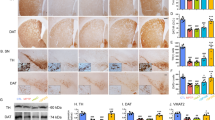Abstract
There is increasing evidence that administration of histone deacetylase (HDAC) inhibitors can exert neuroprotective effects by a variety of mechanisms. Phenylbutyrate is a well-known HDAC inhibitor, which increases gene transcription of a number of genes, and also exerts neuroprotective effects. These include several antioxidant enzymes, chaperones, and genes involved in cell survival. We examined whether administration of phenylbutyrate could exert significant neuroprotective effects against 1-methyl-4-phenyl-1,2,3,6-tetrahydropyridine (MPTP), which has been used to model Parkinson’s disease. Administration of phenylbutyrate significantly attenuated MPTP-induced depletion of striatal dopamine and loss of tyrosine hydroxylase-positive neurons in the substantia nigra. These findings provide further evidence that administration of phenylbutyrate may be a useful approach for the treatment of neurodegenerative diseases.
Similar content being viewed by others
References
Beal M. F., Ferrante R. J., Henshaw R., et al. (1995) 3-Nitropropionic acid neurotoxicity is attenuated in copper/zinc superoxide dismutase transgenic mice. J. Neurochem. 65, 919–922.
Beal M. F., Matson W. R., Storey E., et al. (1992) Kynurenic acid concentrations are reduced in Huntington’s disease cerebral cortex. J. Neurol. Sci. 108, 80–87.
Beal M. F., Matson W. R., Swartz K. J., Gamache P. H., and Bird E. D. (1990) Kynurenine pathway measurements in Huntington’s disease striatum: evidence for reduced formation of kynurenic acid. J. Neurochem. 55, 1327–1339.
Chang J. G., Hsieh-Li H. M., Jong Y. J., Wang N. M., Tsai C. H., and Li H. (2001) Treatment of spinal muscular atrophy by sodium butyrate. Proc. Natl. Acad. Sci. USA 98, 9808–9813.
Corcoran L. J., Mitchison T. J., and Liu Q. (2004) Anovel action of histone deacetylase inhibitors in a protein aggresome disease model. Curr. Biol. 14, 488–492.
Czubryt M. P., McAnally J., Fishman G. I., and Olson E. N. (2003) Regulation of peroxisome proliferator-activated receptor gamma coactivator 1 alpha (PGC-1 alpha) and mitochondrial function by MEF2 and HDAC5. Proc. Natl. Acad. Sci. USA 100, 1711–1716.
Ferrante R. J., Kubilus J. K., Lee J., et al. (2003) Histone deacetylase inhibition by sodium butyrate chemotherapy ameliorates the neurodegenerative phenotype in Huntington’s disease mice. J. Neurosci. 23, 9418–9427.
Hockly E., Richon V. M., Woodman B., et al. (2003) Suberoylanilide hydroxamic acid, a histone deacetylase inhibitor, ameliorates motor deficits in a mouse model of Huntington’s disease. Proc. Natl. Acad. Sci. USA 100, 2041–2046.
Jeong M. R., Hashimoto R., Senatorov V. V., et al. (2003) Valproic acid, a mood stabilizer and anticonvulsant, protects rat cerebral cortical neurons from spontaneous cell death: a role of histone deacetylase inhibition. FEBS Lett. 542, 74–78.
Kaeberlein M., McVey M., and Guarente L. (1999) The SIR2/3/4 complex and SIR2 alone promote longevity in Saccharomyces cerevisiae by two different mechanisms. Gene Dev. 13, 2570–2580.
Kang H. L., Benzer S., and Min K. T. (2002) Life extension in Drosophila by feeding a drug. Proc. Natl. Acad. Sci. USA 99, 838–843.
Leoni F., Zaliani A., Bertolini G., et al. (2002) The antitumor histone deacetylase inhibitor suberoylanilide hydroxamic acid exhibits antiinflammatory properties via suppression of cytokines. Proc. Natl. Acad. Sci. USA 99, 2995–3000.
Maehara K., Uekawa N., and Isobe K. (2002) Effects of histone acetylation on transcriptional regulation of manganese superoxide dismutase gene. Biochem. Biophys. Res. Comm. 295, 187–192.
McCampbell A., Taye A. A., Whitty L., Penney E., Steffan J. S., and Fischbeck K. H. (2001) Histone deacetylase inhibitors reduce polyglutamine toxicity. Proc. Natl. Acad. Sci. USA 98, 15,179–15,184.
McGuinness M. C., Lu J. F., Zhang H. P., et al. (2003) Role of ALDP (ABCD1) and mitochondria in X-linked adrenoleukodystrophy. Mol. Cell Biol. 23, 744–753.
McKinsey T. A., Zhang C. L., and Olson E. N. (2000) Activation of myocyte enhancer factor-2 transcription factor by calcium/calmodulin-dependent protein kinase-stimulated binding of 14-3-3 to histone deactylase 5. Proc. Natl. Acad. Sci. USA 97, 14400–14405.
Minamiyama M., Katsuno M., Adachi H., et al. (2004) Sodium butyrate ameliorates phenotypic expression in a transgenic mouse model of spinal and bulbar muscular atrophy. Hum. Mol. Genet. 13, 1183–1192.
Naya F. J., Black B. L., Wu H., et al. (2002) Mitochondrial deficiency and cardiac sudden death in mice lacking the MEF2A transcription factor. Nat. Med. 8, 1303–1309.
Onyango P., Celic I., McCaffery M., et al. (2002) SIRT3, a human SIR2 homologue, is an NAD-dependent deacetylase localized to mitochondria. Proc. Natl. Acad. Sci. USA 99, 13653–13658.
Puigserver P. and Spiegelman B. M. (2003) Peroxisome proliferator-activated receptor-gamma coactivator 1 alpha (PGC-1 alpha): transcriptional coactivator and metabolic regulator. Endocr. Rev. 24, 78–90.
Ryu H., Lee J., Olofsson B. A., et al. (2003) Histone deacetylase inhibitors prevent oxidative neuronal death independent of expanded polyglutamine repeats via an Sp1-dependent pathway. Proc. Natl. Acad. Sci. USA 100, 4281–4286.
Schulz J. B., Henshaw D. R., MacGarvey U., and Beal, M. F. (1996) Involvement of oxidative stress in 3-nitropropionic acid neurotoxicity. Neurochem. Int. 29, 167–171.
Steffan J. S., Bodai L., Pallos J., et al. (2001) Histone deacetylase inhibitors arrest polyglutamine-dependent neurodegeneration in Drosophila. Nature 413, 739–743.
Tissenbaum H. A. and Guarente L. (2001) Increased dosage of a sir-2 gene extends lifespan in Caenorhabditis elegans. Nature 410, 227–230.
Wu H., Kanatous S. B., Thurmond F. A., et al. (2002) Regulation of mitochondrial biogenesis in skeletal muscle by CaMK. Science 296, 349–352.
Youn H. D., Grozinger C. M., and Liu J. O. (2000) Calcium regulates transcriptional repression of myocyte enhancer factor 2 by histone deacetylase 4. J. Biol. Chem. 275, 22,563–22,567.
Author information
Authors and Affiliations
Corresponding author
Rights and permissions
About this article
Cite this article
Gardian, G., Yang, L., Cleren, C. et al. Neuroprotective effects of phenylbutyrate against MPTP neurotoxicity. Neuromol Med 5, 235–241 (2004). https://doi.org/10.1385/NMM:5:3:235
Received:
Accepted:
Issue Date:
DOI: https://doi.org/10.1385/NMM:5:3:235




